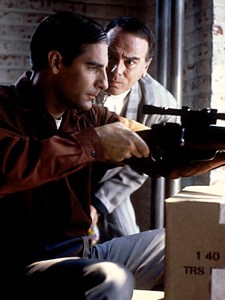“Lee Harvey Oswald”: March 21, 1963; October 5-6, 1957; January 6, 1959; October 21, 1959; April 10, 1963; October 21, 1963; November 21 & 22, 1963
Original airdate: September 22, 1992
Visit the Quantum Leap Rewatch index
The lion’s share of Sam’s leaps take him into the lives of unknown U.S. citizens, directing him to meddle in a chain of events that affects a handful of people. He grapples with the intimate issues faced by ordinary folk: heartbreak, grief, poverty, and fracturing family ties. When he does get into politically sticky situations, whether it’s confronting sexual harassment or fighting racial segregation, his actions still lie, largely, within the realm of the personal.
Here and there, of course, he and Al brush past an influential person or event, having glancing encounters with the likes of Woody Allen, Jack Kerouac, and Bill Clinton. In Quantum Leap, Sam even inspires the invention of games like Trivial Pursuit and a powerful scene in the movie Rocky.
But history with a capital H—the big events that shaped the twentieth century, and the power to affect them—that kind of potentially world-changing leap wasn’t a major part of Sam’s time-travel package until the show’s fifth and final season. In “Honeymoon Express,” for example, Al tried to get Sam to affect a major Cold War event, and he failed utterly.
In the two-part opener of season five however, all bets were off, and Sam kicked off a string of celebrity leaps with the two-part “Lee Harvey Oswald.”
Sam first leaps into Oswald in 1963, but something goes wrong and he skips backward to 1959. The reasons for the bouncing around are initially murky, but what is obvious is that Sam’s mental and emotional transference with his Leapee is unusually strong on the Oswald leap. In the normal course of events, Sam is mostly himself. He has a trace of his “host” to work with—a little bit of personality, usually, but not much else. This time he ends up with Oswald’s knowledge—he can speak Russian, and carry out his duties on a military base in Japan. He also has Oswald’s hairtrigger temper, and try as he might he can’t seem to control it.
But why has Sam found himself shackled, in this unfortunate way, to Oswald? The obvious conclusion, according to Al, is that he is there to affect the assassination, probably by uncovering Oswald’s co-conspirators. But as the leap goes on, Sam fails to find a single accomplice. He continues to lose control of Oswald, and each mini-leap brings them closer to Dallas.
“Lee Harvey Oswald” reflects series creator Donald Bellisario’s belief that Oswald acted alone when he killed Kennedy, and the multiple leaps in this episode are a series of vignettes, based on Oswald’s biography, that portray him as a reactionary and deeply disturbed young man. The most intense of these scenes takes place in the U.S.S.R., when Al has advised Sam that his best chance of reasserting control over Oswald is to follow the original history precisely. The catch, unfortunately, is that Sam has jumped into Oswald just before a suicide attempt. This is one of those unforgettable Sam-Al moments, fraught with tension: neither of them is keen on the idea of Sam cutting his wrists, so Al is forced to reluctantly egg him on and, as always, to bear witness.
And, as it becomes obvious that the assassination cannot be prevented, it is Al who saves Sam from pulling the trigger himself.
“Lee Harvey Oswald” concludes with some delicate footwork on the part of its screenwriters. The entire nature of Quantum Leap would have changed if Sam could actually rewrite U.S. history. As a result, the story concludes with his having been an important part of the events we all remember. But “Lee Harvey Oswald” opens the door to other glamorous, big-history leaps: later in the year, Sam finds himself leaping into Marilyn Monroe’s chauffeur, and his last leap before the final episode, “Mirror Image,” has him launching the career of none other than Elvis Presley.
Speaking of penultimate episodes, this blog entry marks my second-last of the rewatches selected by all of you. Next week I will wrap up this series with a rewatch of “Deliver us from Evil.”
A.M. Dellamonica writes novels and short fiction and teaches writing online. She is passionate about environmentalism, food and drink, and art in every form, and dabbles in several: photography, choral music, theater, dance, cooking and crafts. Catch up with her on her blog here.










